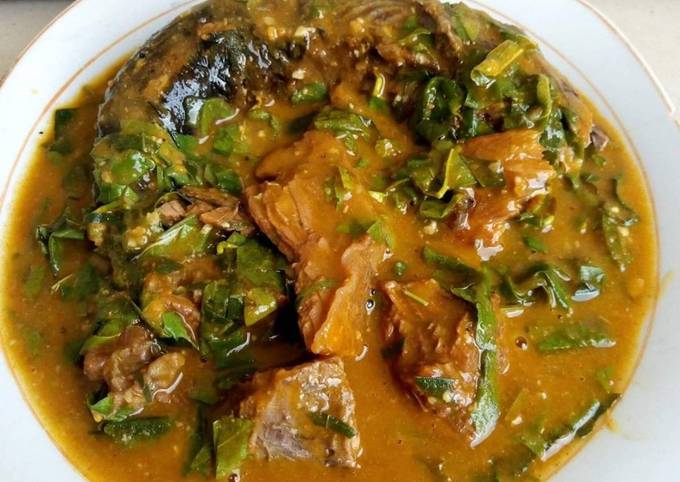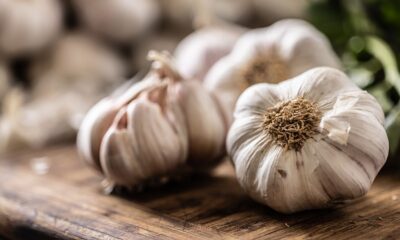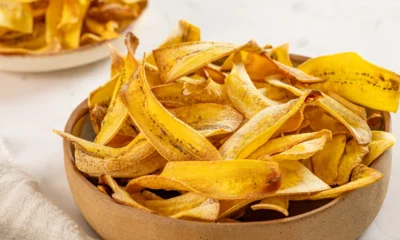Oha soup, also called Ora soup, is a delicious and nutritious dish from the southeastern region of Nigeria. Known for its unique taste and texture, Oha soup is a popular staple among the Igbo people and is cherished for its rich blend of flavours, leafy greens, and thick consistency.
This recipe breaks down the steps to make an authentic Oha soup at home.
Ingredients You Will Need for Oha Soup
To make Oha soup, gather these essential ingredients:
- Oha leaves (Ora leaves) – 1 handful (finely chopped)
- Cocoyam – 8-10 small pieces (for thickening)
- Palm oil – 2-3 tablespoons
- Beef or goat meat – 500 grams
- Stockfish – 1 cup (optional)
- Dry fish – 1 cup
- Snails – 1 cup (optional)
- Ground crayfish – 2 tablespoons
- Ogiri (fermented locust beans) – 1 teaspoon
- Fresh pepper – to taste
- Seasoning cubes – 2
- Salt – to taste
Waterleaf or spinach – 1 handful (optional, for extra greens)
- Optional proteins – Oha soup is versatile and can be prepared with a variety of proteins, including cow tripe (shaki), chicken, and cow skin (ponmo). Feel free to add or substitute based on preference.
Step 1: Prepare the Ingredients
1. Use your fingers to tear the Oha leaves into small pieces. Avoid cutting with a knife, as it can make the leaves darker and affect the taste.
2. Wash and boil the cocoyam until it becomes tender. Then, pound it into a smooth paste using a mortar and pestle. This serves as the soup thickener.
3. Wash your beef, dry fish, and other meats thoroughly. Cut into desired sizes and season with salt and seasoning cubes.
Step 2: Cook the Meat and Stock
1. In a large pot, add the beef, stockfish, dry fish, and snails (if using). Season with salt and seasoning cubes.
2. Pour enough water to cover the meats, then cover the pot and allow it to cook for 30-40 minutes until the meat becomes tender and flavorful.
3. Taste the stock and adjust the seasoning if necessary. This is crucial because the stock forms the base of the soup.
Step 3: Add Palm Oil and Cocoyam Paste
1. Once the meat is cooked, add the palm oil directly into the pot. Stir well and allow it to cook for about 5 minutes to dissolve in the stock.
2. Take spoonfuls of the pounded cocoyam paste and add them to the pot. This thickens the soup, giving it a rich, creamy consistency.
3. Stir gently and allow the cocoyam to dissolve fully. This usually takes around 10-15 minutes. The soup should thicken gradually.
Step 4: Add Crayfish, Ogiri, and Fresh Pepper
1. Sprinkle in the ground crayfish for a deeper flavour.
2. Ogiri adds a traditional, slightly pungent taste to the soup. Add it in small amounts to avoid overpowering the dish.
3. Include fresh pepper according to your spice preference. Stir the ingredients well and let everything simmer together for another 5 minutes.
Step 5: Add the Vegetables
1. Add waterleaf or spinach: This step is optional but recommended for extra greens and a touch of freshness.
2. Finally, add the Oha leaves to the pot. Stir them gently into the soup and let them cook for 2-3 minutes. Be careful not to overcook the leaves, as they are delicate and can lose their colour and flavour.
Step 6: Serve and Enjoy
Your Oha soup is now ready! Serve it hot with your favourite swallows, such as pounded yam, fufu, or eba. The rich flavours of the meats, fish, and vegetables come together in this hearty dish, making it a truly satisfying meal.

Tips for a Perfect Oha Soup
- Use fresh Oha leaves: The taste of Oha soup is best when the leaves are fresh.
- Avoid using a knife on the leaves: Tearing the leaves by hand preserves their natural colour and prevents bitterness. It also makes the leaves more visible and lasting in the soup.
- Balance the ogiri: Ogiri has a strong flavour, so add it gradually until you reach the desired taste.
Nutritional Benefits of Oha Soup
Oha soup is not only delicious but also packed with nutrients. It is a good source of protein (from meat and fish), healthy fats (from palm oil), and fibre (from vegetables).
Cocoyam provides complex carbohydrates, which give you lasting energy. Additionally, Oha leaves contain essential vitamins and minerals that boost immunity and improve skin health.
What can I use to thicken Oha soup if I don’t have cocoyam?
If you don’t have cocoyam, you can use achi, ofor, or even yam as a substitute thickener. These alternatives will help achieve a similar consistency and are also commonly used in Nigerian soups.
Can I make Oha soup without ogiri?
Yes, you can make Oha soup without ogiri, though it may lack the unique flavour ogiri provides. If you don’t like ogiri or cannot find it, you can substitute it with iru (locust beans), which offers a milder flavour.
How do I store leftover Oha soup?
To store Oha soup, let it cool completely before transferring it to an airtight container. Store it in the refrigerator for up to 3 days or in the freezer for up to a month.
Reheat on the stove, adding a little water if the soup has thickened too much.
Oha soup is a flavorful and nutritious dish that reflects the richness of Nigerian cuisine. With its unique combination of ingredients, this recipe provides a delightful experience that’s perfect for family gatherings or festive occasions.
Follow these steps to create an authentic, satisfying Oha soup, and enjoy the warm taste of traditional Nigerian cooking right in your kitchen.
For more food articles and recipes, visit here.

 MUSIC6 days ago
MUSIC6 days ago
 NEWS6 days ago
NEWS6 days ago
 FAB FRESH5 days ago
FAB FRESH5 days ago
 LIFESTYLE5 days ago
LIFESTYLE5 days ago
 ENTERTAINMENT6 days ago
ENTERTAINMENT6 days ago
 BEAUTY6 days ago
BEAUTY6 days ago
 ENTERTAINMENT5 days ago
ENTERTAINMENT5 days ago
 FAB FRESH5 days ago
FAB FRESH5 days ago



















































